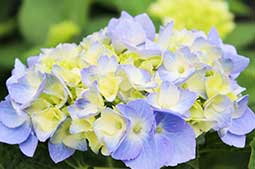Hydrangeas
Few shrubs can rival the form and unique flowers that hydrangeas bring to your landscape. Hydrangeas have a coarse texture which combines well with the smaller leaves of azaleas, Japanese hollies, fine-needled evergreens, and many perennials. They produce long-lasting flowers in a variety of colors that dry beautifully. 
Types of Hydrangeas:
Bigleaf
- Mophead - Large rounded pink, blue or white flowers
- Lacecap - Large "pinwheel" flowers)
- Examples: Endless Summer Series, Forever and Ever Series, and Let's Dance Series.
Oakleaf
- Large, white, conical flowers
- Oak-shaped leaves
- Examples: Ruby Slippers and Peewee.
Smooth
- Large white or pink flowers
- Examples would be Incrediball and Invincibelle Spirit.
P. G.
- Large, white conical flowers.
- Examples: Limelight, Little Lime, and Quickfire.
Bigleaf Hydrangeas prefer partial shade and moist, well-drained soil. Flower color is usually pink or blue (depending on the soil PH) with a few varieties that are white or blush white. To get the best blue pH should be between 4.5 and 5.5. Use Espoma Organic Soil Acidifier to have a more acidic soil (lower the number). To achieve the best pink/red color pH should be between 6.5 and 7.5. Add Espoma Organic Garden Lime to the soil to make it sweeter (increase number). Light shade helps to intensify color. Most newer cultivars of Mophead Hydrangeas will bloom on new wood as well as old wood. This is a great advantage over the older cultivars which only bloomed on old wood. If they die back in winter, or you cut them them back in fall or early spring, you would not get any flowers that summer because Mophead Hydrangeas form their flower buds in late summer and fall. With the newer plants you will still get flowers even if they die back in winter. They generally will bloom for a more extended period in season. 
Mophead Hydrangeas have a shallow, fibrous root system. The need to water them during dry spells cannot be overemphasized. It is also one of the first plants to wilt when plants are under drought stress. Thus, a wilted hydrangea often indicates the need of all garden and yard plants for water. If a hydrangea becomes overly dry, it may suffer leaf “burn” or “scorch” during hot, dry weather. If you need to prune your hydrangea, the best time is right after it flowers.
Oakleaf Hydrangeas will grow in full sun to almost full shade (flowering may be less.) The large conical flowers are white and will fade to pink and then brown. The fall color is superb-reds and burgundy. The sizes of oakleaf hydrangeas range greatly from 3-4’ to 12’ tall and wide. Make sure you give the larger growing ones room! Pruning of this type should be done right after flowering.
Smooth Hydrangea are great for sun or part sun areas. They grow 3-5’ with white or pink flowers. These make great low hedges or mixed in flower beds. It is best to prune smooth Hydrangeas to the ground in early spring. The size of the flowers sometimes will cause them to flop over.
P.G. Hydrangeas are great for the sun or part sun. They make good foundation plants or shrub borders. The flowers are a large conical shape and generally start out white and turn pink as the flower ages. The size ranges from 3-4’ to 6-8’ tall. The best time to prune these is in early spring. This type of hydrangea also comes in a tree form, which makes a nice summer blooming small tree.
Fertilizing hydrangeas will help keep them blooming and growing well. We recommend using Espoma Organic Rose-Tone or Bumper Crop Rose & Flower Food.
